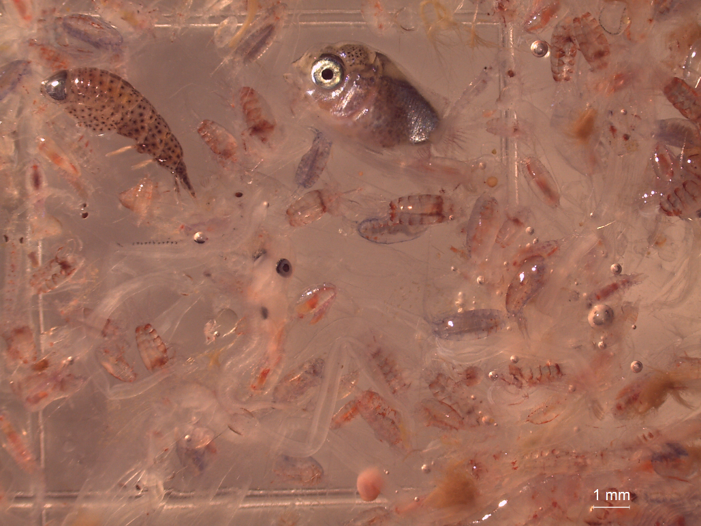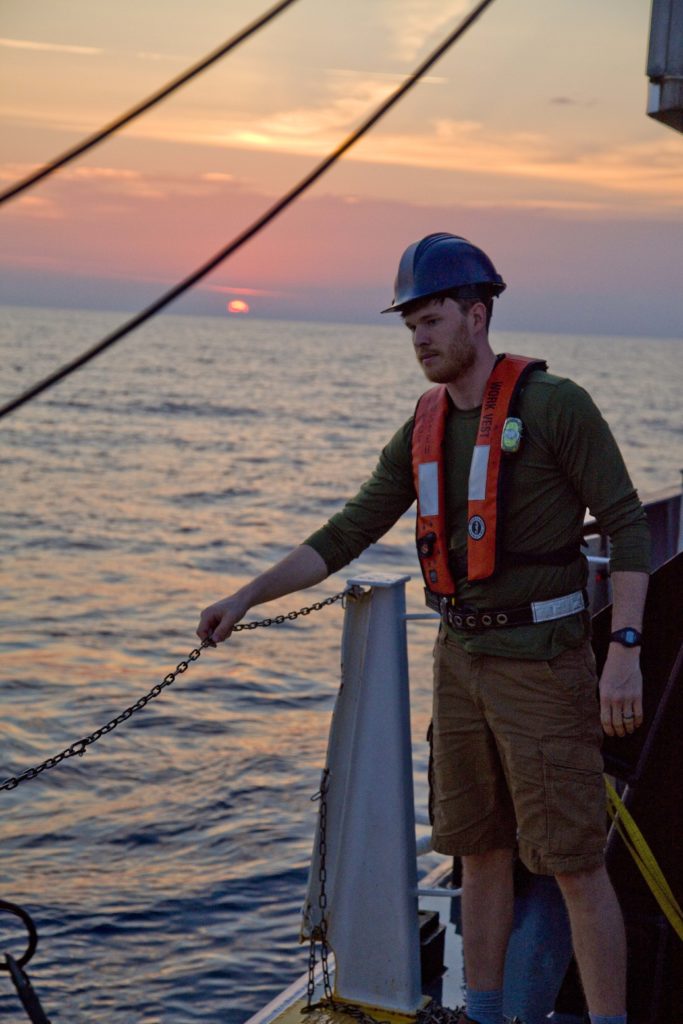
Reporting by Helen Hill for MITgcm
Taylor Shropshire is a graduate student at Florida State University (FSU) working in Mike Stukel’s Plankton Ecology and Biogeochemistry Lab and also at the Center for Ocean-Atmospheric Prediction Studies (COAPS). As a part of his Masters’ dissertation research, Shropshire used MITgcm to perform three-dimensional models of ocean circulation and plankton dynamics to understand the impact of a changing climate on key commercial fish species in the Gulf of Mexico.

Taylor is a graduate student at FSU working in the FSU Plankton Ecology and Biogeochemistry Lab and also at the Center for Ocean-Atmospheric Prediction Studies (COAPS). He uses three-dimensional models of ocean circulation and plankton dynamics to understand the impact of a changing climate on key commercial fish species in the Gulf of Mexico and started using MITgcm in 2016, performing offline biogeochemical and lagrangian larval fish simulations. For his Ph.D. research, Taylor is now focused on estimating food limitation of larval fish and ultimately annual mortality variability in order to better understand larval starvation and provide information to stock assessment models used to manage fisheries. He expects to defend in 2020. When he’s not modeling the ocean he says he enjoys hiking/backpacking, woodworking, and playing basketball at local parks.
As a part of his Masters’ dissertation research, Shropshire used MITgcm to perform three-dimensional simulations of ocean circulation coupled with a biogeochemical model to understand zooplankton dynamics in the Gulf of Mexico.
Although zooplankton play an important role in global biogeochemistry as well as providing the food to support valuable fisheries in the world’s oceans they are difficult to study in the field and their abundances cannot currently be estimated using remote sensing techniques. Therefore, coupled physical-biogeochemical models (PBMs) provide an important oceanographic research tool for studying zooplankton on regional and global scales.
Unfortunately, however, because of a lack of ship-based observations, evaluating the accuracy of zooplankton abundance estimates from PBMs can be a challenge, and as a result, zooplankton dynamics have tended to be understudied and under validated in PBMs.
For his Masters dissertation research, Shropshire configured a PBM for the Gulf of Mexico and validated the model against an extensive combination of in-situ biomass and rate measurements including total mesozooplankton biomass, mesozooplankton size distribution, mesozooplankton specific grazing rates, microzooplankton specific grazing rates, surface chlorophyll, depth of the chlorophyll maximum, phytoplankton specific growth rates, and net primary production.
“To efficiently run large numbers of three-dimensional simulations needed for basin-scale tuning, the PBM was run in an offline environment utilizing the MITgcm offline tracer advection package with physical prognostic variables (ie, temperature, salinity, and three-dimensional velocity fields) prescribed from daily-averaged flow fields saved from a hydrodynamic model integration that was previously performed using HyCOM,” explains Shropshire.
Analyzing his results, Shropshire found that spatial variability in mesozooplankton biomass (corresponding to zooplankton in the size class 0.2 – 5 mm) observed in a multi-decadal database for the northern Gulf of Mexico was well resolved by his model.
“Model results from shelf regions suggested that herbivory appeared to be the dominant feeding mode for small mesozooplankton (<1 mm) whereas large mesozooplankton (1-5 mm) were primarily carnivorous,” Shropshire says. “However, in open-ocean, oligotrophic regions, both groups of mesozooplankton were found to exhibit a proportionally greater reliance on protistan zooplankton as a food source.”
Shropshire interprets this result as highlighting the important role of microbial and protistan food webs in sustaining mesozooplankton biomass in the Gulf of Mexico. Shropshire notes that mesozooplankton biomass is necessary for the survival of larval fish and hence the population state of many commercially important fish species, including tuna. He is currently preparing a manuscript detailing his thesis work for the journal Biogeosciences with co-authors Michael R Stukel, Steve Morey, Eric Chassignet, Mandy Karnauskas, Alex Bozec, Glenn Zapfe, Rasmus Swalethorp, Michael R Landry, and Victoria J Coles.
Future work includes using zooplankton biomass model estimates to investigate food limitation experienced by larval fish in current and future climate conditions.
To find out more about this work contact Taylor.
Story image: Zooplankton collected in the Gulf of Mexico – credit: Southeast Fisheries Science Center FORCES lab
This Month’s Featured Publication
- Taylor Shropshire (2019), Quantifying Spatiotemporal Variability in Zooplankton Dynamics in The Gulf of Mexico Using A Physical-Biogeochemical Model, Masters Thesis of the Florida State University, https://search.proquest.com/openview/6421770404b5d9b3eb65f26160cbcc3a
Other New Publications this Month
Nils Brüggemann and Caroline A. Katsman (2019), Dynamics of downwelling in an eddying marginal sea: contrasting the Eulerian and the isopycnal perspective, Journal of Physical Oceanography, doi: 10.1175/JPO-D-19-0090.1
M. Brunetti, J. Kasparian, C. Vérard (2019), Co-existing climate attractors in a coupled aquaplanet, Climate Dynamics, doi: 10.1007/s00382-019-04926-7
Tansu Daylan et al (2019), TESS observations of the WASP-121 b phase curve, arXiv:1909.03000 [astro-ph.EP]
Tiago S. Dotto, Alberto C. Naveira Garabato, Sheldon Bacon, Paul R. Holland, Satoshi Kimura, Yvonne L. Firing, Michel Tsamados, Anna K. Wåhlin, and Adrian Jenkins (2019), Wind-driven processes controlling oceanic heat delivery to the Amundsen Sea, Antarctica, Journal of Physical Oceanography, doi: 10.1175/JPO-D-19-0064.1
Patrick G. J. Irwin, Vivien Parmentier, Jake Taylor, Jo Barstow, Suzanne Aigrain, Graham K.H. Lee, and Ryan Garland (2019), 2.5-D retrieval of atmospheric properties from exoplanet phase curves: Application to WASP-43b observations, arXiv: 1909.03233 [astro-ph.EP]
Fanni Dóra Kelemen, Cristina Primo, Hendrik Feldmann, and Bodo Ahrens (2019), Added Value of Atmosphere-Ocean Coupling in a Century-Long Regional Climate Simulation, Atmosphere, doi: 10.3390/atmos10090537
Samuel M. Kelly (2019), Coastally generated near-inertial waves, Journal of Physical Oceanography, doi: 10.1175/JPO-D-18-0148.1
Svetlana N. Losa, Stephanie Dutkiewicz, Martin Losch, Julia Oelker, Mariana A. Soppa, Scarlett Trimborn, Hongyan Xi, and Astrid Bracher (2019), Supplementary Material: On Modeling the Southern Ocean Phytoplankton Functional Types, https://www.biogeosciences-discuss.net/bg-2019-289/bg-2019-289-supplement.pdf
R. C. Musgrave (2019), Energy fluxes in coastal trapped waves, Journal of Physical Oceanography, doi: 10.1175/JPO-D-18-0172.1
William Pluriel, Jérémy Leconte, Tiziano Zingales, Vivien Parmentier, Ingo Waldmann, and Anthony Caldas (2019), Unravelling the biases of transmission spectroscopy due to the three-dimensional structure of exo-atmospheres, EPSC Abstracts, Vol. 13, EPSC-DPS2019-810-1, 2019, https://meetingorganizer.copernicus.org/EPSC-DPS2019/EPSC-DPS2019-810-1.pdf
Michael A. Spall (2019), Dynamics and thermodynamics of the mean Transpolar Drift and ice thickness in the Arctic Ocean, Journal of Climate, doi: 10.1175/JCLI-D-19-0252.1
Andrea Storto, Antonio Bonaduce, Xiangbo Feng, and Chunxue Yang (2019), Steric Sea Level Changes from Ocean Reanalyses at Global and Regional Scales, Water, doi: 10.3390/w11101987
Do you have news about research using MITgcm? We are looking for contributions to these pages. If you have an interesting MITgcm project (ocean, atmosphere, sea-ice, physics, biology or otherwise) that you want to tell people about, get in touch. To make a post, contact Helen
